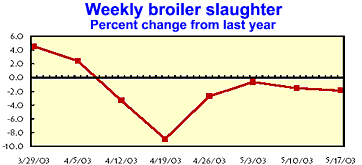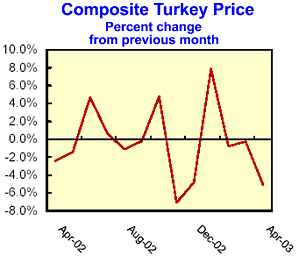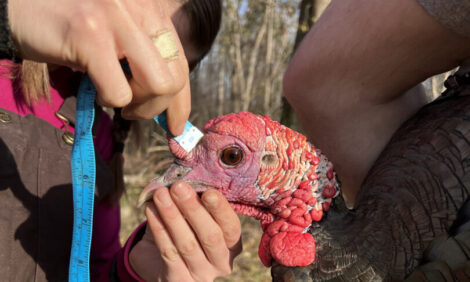



Poultry Outlook Report - May 2003
By U.S.D.A., Economic Research Service - This article is an extract from the April 2003: Livestock, Dairy and Poultry Outlook Report, highlighting Global Poultry Industry data. This report indicates that both broiler production and exports are expected to increase in 2004.| Overview |

Poultry production is expected to respond to expected higher broiler prices in 2003 and 2004 than in 2002 and lower feed costs in 2004.
Broiler prices in 2003 and 2004 are expected to average about 5 cents above 2002’s 55.6 cents
per pound. Both broiler production and exports are expected to increase in 2004. Meat and poultry exports are expected to increase 3-4 percent in 2004, compared with a likely 3-percent gain this year.
All major meats are expected to post gains in both 2003 and 2004.
| Broiler Production Down, Turkey Production Even in First-Quarter 2003 |

U.S. broiler production totaled 7.735 billion pounds in the first quarter of 2003, down 1.1 percent from a year earlier. The reduction was due to a 2.5-percent reduction in the number of birds being slaughtered. The reduction in the number of birds slaughtered was partially offset by a 1.2- percent increase in average bird weight at slaughter to 5.17 pounds.
This pattern is expected to continue into the second quarter of 2003 with production forecast at 8.15 billion pounds, down 1 percent from the previous year. During April, the weekly broiler slaughter reported by the Agricultural Marketing Service (AMS) averaged around 3 percent lower than during the same weeks a year earlier. Again the decline was in the number of birds being slaughtered and was being somewhat offset by higher average bird weights.
Other indicators pointing to lower future production are the weekly declines in the number of chicks placed for growout. Over the last 6 weeks (through April 30) the number of chicks being placed for growout has continued to average slightly less than 1 percent lower than in the same period the previous year.
 Broiler production for 2004 is forecast at 32.7 billion pounds, up only 1-2 percent from 2003
as large overall supplies of meat products (down from 2003, but still the third highest ever) and slow growth in the export market hold down growth in prices.
Broiler production for 2004 is forecast at 32.7 billion pounds, up only 1-2 percent from 2003
as large overall supplies of meat products (down from 2003, but still the third highest ever) and slow growth in the export market hold down growth in prices.
Turkey production totaled 1.379 billion pounds in first-quarter 2003, about even with the previous year (1.378 billion pounds in first-quarter 2002). The situation with turkey production was the opposite from broilers, with the overall number of birds going to slaughter increasing slightly, but the increase in bird numbers being completely offset by slightly lower average weights.
During the fourth quarter of 2002 and the first quarter of 2003 the number of poults being placed for growout has totaled 145.6 million birds, down 2.1 percent from the same period a year earlier. Turkey production for the second quarter is forecast at 1.425 billion pounds, down slightly more than 1 percent from the previous year. Turkey production in 2004 is expected to reach 5.78 billion pounds, 1-2 percent higher than the previous year. With almost no growth expected in exports, per capita consumption of turkey is expected to reach almost 18 pounds in 2004.
| Broiler Stocks Down, but Turkey Stocks Higher |

Broiler stocks for the end of first-quarter 2003 were 641 million pounds, down 20 percent from 804 million pounds the previous year. Most of the decline came in lower holdings of broiler parts.
At the end of the first quarter, stocks of broiler parts totaled 619 million pounds down 20 percent lower than a year earlier.
Stocks of whole birds were also lower, falling to 23 million pounds or 22 percent lower than the previous year.
With the lower stocks and anticipated lower production in the second quarter, broiler prices for a number of parts, especially those consumed chiefly in the domestic market, are expected to gradually strengthen.
Ending turkey stocks for the first quarter of 2003 were 533 million pounds, 16 percent higher than the previous year.
 There was a wide difference in the stock levels for whole birds and parts. Stocks of whole birds were down 3 percent from the previous year, while stocks of turkey parts totaled 318 million, up 35 percent from a year earlier.
There was a wide difference in the stock levels for whole birds and parts. Stocks of whole birds were down 3 percent from the previous year, while stocks of turkey parts totaled 318 million, up 35 percent from a year earlier.
The stock levels were reflected in first-quarter prices, with prices for whole birds (toms and hens) averaging 2 percent higher, while the first-quarter prices for most turkey parts were lower than during the same period in 2002.
| Broiler Export Forecast Lowered for 2003 |
The broiler export forecast for 2003 has been reduced to 5 billion pounds. This is a reduction of 125 million pounds from previous forecasts. The lower forecast is chiefly due to lowered projections for economic growth in a number of Asian countries and lower than expected exports to Mexico.
The forecasts have already taken into account the import quotas to Russia that began on April 29 and assume that U.S. companies will export the quota maximum and that most of the
exports will be broiler products. The broiler export forecast for 2004 is 5.2 billion pounds, up 4 percent from the previous year. The growth is expected to come from higher shipments to Asia. However, there still is some uncertainty about the level of broiler shipments that will be allowed into Russia during 2004.
| Poultry Year in Review 2002 Production Grows, but Exports Decline in 2002 |
U.S. poultry (broiler, turkey, and other chicken) production in 2002 reached 38.1 billion pounds on a net ready-to-cook (RTC) basis, up 3.2 percent from 2001. Domestic consumption increased 5.7 percent over 2001, absorbing the increased supplies available on the domestic market as exports fell by 13.6 percent. The decrease in exports was due mainly to lower broiler shipments, which were impacted by a ban over part of the year on exports to Russia and partial bans by other countries in response to disease outbreaks in the United States.
For both broilers and turkey, falling exports also led to increases in stocks, placing downward pressure on prices. In 2003, poultry production is expected to be down slightly from 2002. Total poultry exports are forecast to increase, but remain well below the record levels in 2001. Exports to Russia over the first half of 2003 are expected to rise compared with reduced levels of 2002. However, exports to Russia in the second half of the year will be limited by the quotas that have been placed on poultry imports.
| Broiler Prices Down in 2002; But Expected To Be Higher in 2003 |
Federally inspected net broiler production rose 3.1 percent in 2002, to 31.9 billion pounds. However, production is expected to fall in 2003, with net broiler production expected to decline slightly from 2002. The increase in broiler production in 2002 was the result of a 1.6-percent increase in the number of birds slaughtered and a 1.5-percent increase in average bird weights.
The wholesale composite price for chicken fell by 9 percent in 2002, to 56.2 cents a pound, but the composite retail price for chicken rose by 2.5 percent. The decline in the wholesale composite price was primarily a reflection of lower prices for wings, drumsticks, and thighs as wholesale prices.
The growth in the retail composite chicken price also reflects the relative strength of breast meat prices, as increases in breast meat prices offset declining prices for whole birds and legs.
Total U.S. broiler exports fell by 13.6 percent in 2002. The exports of 4.8 billion pounds accounted for about 15 percent of U.S. broiler production. Exports fell mainly because of the decrease in shipments to Russia, which totaled 1.5 billion pounds in 2002, down 34 percent from the previous year but still 32 percent of all U.S. broiler exports. The decrease was chiefly due to a ban that Russia had placed on imports of U.S. poultry for a portion of the year.
China and Hong Kong combined represent the second-largest market (16 percent) for U.S. broiler
exports, totaling about 764 million pounds in 2002. In 2002, total broiler exports to Mexico amounted to 325 million pounds, a decrease of about 15 percent from 2001. Mexico remained the third largest market for U.S. broiler exports, but the economic slowdown that impacted the U.S. economy also impacted economic activity in Mexico.
Other countries showing considerable growth in U.S. broiler imports were Korea, Guatemala, Haiti, and Cuba. Although trade regulations make exports to Cuba more difficult, broiler exports in 2002 totaled over 93 million pounds. Another interesting development was a 59-percent jump in exports to Angola. With total shipments of 105 million pounds in 2002, Angola was the ninth largest market in terms of volume.
Broiler exports are expected to increase by 4.2 percent in 2003. Although there is a quota on
exports to Russia starting on May 1, total exports to Russia for 2003 are expected to be higher than in 2002. Mexico’s reduction of its tariffs on many broiler products is also expected to boost shipments over the 2002 levels. With no new disease outbreaks, shipments are also expected to increase to the China/Hong Kong market and to Japan.
| Russia Places Quota on Poultry Imports |
Over the last several years Russia has become the key market for U.S. broiler exports. In 2001
broiler exports to Russia totaled 2.3 billion pounds or 41 percent of total U.S. exports and 7 percent of total U.S. broiler production. Starting May 1, 2003, Russia has placed a quota on imports of poultry products.
The quota for May 1 through the end of 2003 will be 744,000 metric tons. Of this total the United States has been allocated 553,500 metric tons. However, 141,100 tons of the U.S. quota has been specifically put aside for imports of mechanically deboned meat (MDM). In 2002, 76
percent (521,000 metric tons) of all the U.S. broiler products shipped to Russia were frozen leg quarters. With the quota of 141,100 metric tons for MDM, this leaves only 412,300 metric tons for other products such as leg quarters. However, the 521,000 metric tons were shipped over a 12-month period.
Other markets have also been affected by various bans based on disease and food safety issues. On January 1, 2002, the Ukraine banned U.S. chicken imports, citing the use of antibiotics in U.S. broiler production and antimicrobial rinses in U.S. processing plants. The impact of the ban to the Ukraine has been hard to determine because poultry shipments have varied so widely from year to year. Exports to Japan (the fourth largest market by volume) were also interrupted by a series of bans on poultry product imports from specific U.S. States. These bans were based on outbreaks of low-pathogenic strains of Avian Influenza (AI). At different times, bans were enacted on poultry products from Pennsylvania, Maine, Virginia, West Virginia, North Carolina, and Texas.
| Turkey: Exports and Prices Fall Again in 2002 |
U.S. turkey production in 2002 set another record, totaling 5.6 billion pounds (net RTC), 2.7 percent higher than the previous year. The increase was due to a higher number of turkey slaughtered and heavier average weights. The average wholesale whole-bird prices for hens in the East averaged 64.5 cents per pound, down 2.8 percent compared with 2001. Retail whole-bird prices also declined, dropping 4 percent. Most of the increase in production came in the first half of the year, as production in the second half of 2002 was just over 1 percent higher than the previous year. Turkey production is expected to decrease slightly in 2003, and wholesale whole-bird prices are expected to increase 3-4 percent.
U.S. turkey exports in 2002 were 439 million pounds, down almost 10 percent from 2001. Exports accounted for about 8 percent of total production. The decrease in exports came mostly from lower shipments to Mexico. This was the second consecutive year that turkey exports had
declined to Mexico, which is the largest market. Exports to Mexico were likely affected by the
slowdown in its economy. Mexico imports mostly MDM and fresh and chilled turkey parts, which are used to produce sausages and other prepared meats. Adding to the decline were much lower shipments to Russia. The turkey exports to Russia were impacted by the ban on poultry imports that was in place for part of the year.
| Eggs: Higher Production and Falling Exports Push Consumption Upward |
Total U.S. egg production in 2002, table and hatching, totaled 7.2 billion dozen, about 1 percent more than 2001. Egg production is expected to increase only slightly in 2003. Table eggs accounted for 85 percent of total production in 2002, and are expected to maintain the same proportion in 2003. Hatching egg production declined slightly (less than a half of 1 percent), but is expected to rise slightly in 2003. The increase in 2003 is expected to come mostly from higher production of broiler-type eggs.
Wholesale table egg prices averaged 67.1 cents a dozen in 2002, almost exactly the same as in 2001. However, retail egg prices increased by 11 percent, widening the wholesale to retail spread by 48 percent. Retail egg prices had changed little over the previous several years. The wholesale egg market is a relatively thin market, where small changes in supply can have a large price impact.
Per capita egg consumption in 2002 rose slightly to 254.6 eggs, about one egg higher than the previous year. Since the mid-1990s, annual egg consumption has jumped over 20 eggs per person. In large part this is due to increasing demand for breaking eggs by the commercial baking, confections, and fast food industries. Since 1996 the amount of eggs going to the breaking market has risen by about 25 percent and now uses about one-third of total table egg production. Wholesale egg prices in 2003 are expected to increase around 10 percent due to the slowing growth in production.
U.S. egg exports in 2002 were 174 million dozen, down 8 percent from the previous year and 2 percent of total U.S. egg production. Shell eggs (for human consumption and hatching) accounted for almost half of total U.S. exports. Canada, Belgium, Hong Kong, Japan, and Mexico were the largest export markets, receiving nearly threequarters of all U.S. egg exports. The 8-percent increase in exports to Belgium (due to a shortfall in European production) helped to partially offset a 26-percent decline in exports to Japan and a drop of 6 percent in shipments to Mexico. Exports to Canada were up 4.5 percent with shipments (47.4 million dozen) twice as large as those to any other country. U.S. egg exports in 2003 are expected to decline somewhat as EU egg production recovers.
Links
For more information view the full Livestock, Dairy and Poultry Situation and Outlook (pdf)Source: Livestock, Dairy and Poultry Situation and Outlook - U.S. Department of Agriculture, Economic Research Service - 28th May, 2003








